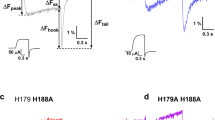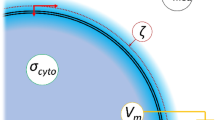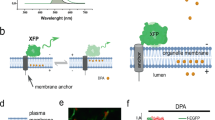Abstract
Extrinsic optical probes have become important tools for monitoring membrane potential, with probes now available for many tissue or cell suspension systems1. In each case that has been studied in detail2–4, it seems that the mechanism involves a shift in the equilibrium population of the probe from one chemical environment to another in response to the transmembrane potential; the environments perturb the probe's spectrum differently. As this indirect mechanism involves a redistribution of dye between chemical environments that are likely to vary if a given probe is transferred from one membrane to another, a potential probe that is effective and calibrated for all membrane systems has not been realised. We present here evidence for a direct response of a probe chromophore to the electric field across membrane systems. The results suggest it might be possible to develop a universal set of membrane probes.
This is a preview of subscription content, access via your institution
Access options
Subscribe to this journal
Receive 51 print issues and online access
$199.00 per year
only $3.90 per issue
Buy this article
- Purchase on Springer Link
- Instant access to full article PDF
Prices may be subject to local taxes which are calculated during checkout
Similar content being viewed by others
References
Cohen, L. B. & Salzberg, B. M. Rev. physiol. biochem. Pharmac. 83, 35–88 (1978).
Waggoner, A. S. & Grinvald, A. Ann. N.Y. Acad. Sci. 303, 217–241 (1977).
Waggoner, A. S., Wang, C. H. & Tolles, R. L. J. Membrane Biol. 33, 109–140 (1977).
Waggoner, A. S. A. Rev. Biophys. Bioengng 8, 847–868 (1979).
Loew, L. M. et al. Biophys. J. 21, 206a (1978).
Loew, L. M., Bonneville, G. W. & Surow, J. Biochemistry 17, 4065–4071 (1978).
Platt, J. R. J. chem. Phys. 25, 80–105 (1956); 34, 862–864 (1961).
Liptay, W. Angew. Chem. Int. Ed. 8, 177–188 (1969).
Tien, H. T. Bilayer Lipid Membranes, 478–480, 483 (Dekker: New York, 1974).
Reich, R. & Schmidt, S. Ber. Bunsenges. Physik. Chem. 76, 589–598 (1972).
Loew, L. M., Simpson, L., Hassner, A. & Alexanian, V. J. Am. chem. Soc. 101, 5439–5440 (1979).
Dragsten, P. R. & Webb, W. W. Biochemistry 17, 5228–5240 (1978).
Loew, L. M., Simpson, L., Hassner, A. & Parkins, H. Biophys. J. 25, 302a (1979).
Author information
Authors and Affiliations
Rights and permissions
About this article
Cite this article
Loew, L., Scully, S., Simpson, L. et al. Evidence for a charge-shift electrochromic mechanism in a probe of membrane potential. Nature 281, 497–499 (1979). https://doi.org/10.1038/281497a0
Received:
Accepted:
Issue Date:
DOI: https://doi.org/10.1038/281497a0
This article is cited by
-
Effect of Local Anesthetics on Dipole Potential of Different Phase Membranes: A Fluorescence Study
The Journal of Membrane Biology (2022)
-
Optical interrogation of neuronal circuitry in zebrafish using genetically encoded voltage indicators
Scientific Reports (2018)
-
Differential Membrane Dipolar Orientation Induced by Acute and Chronic Cholesterol Depletion
Scientific Reports (2017)
-
Combined use of two membrane-potential-sensitive dyes for determination of the Galvani potential difference across a biomimetic oil/water interface
Analytical and Bioanalytical Chemistry (2014)
-
Biolistic Loading of Voltage-Sensitive Dyes into Cells in Rat Brain Slices for Optical Recording of Neuron Activity
Neuroscience and Behavioral Physiology (2013)
Comments
By submitting a comment you agree to abide by our Terms and Community Guidelines. If you find something abusive or that does not comply with our terms or guidelines please flag it as inappropriate.



